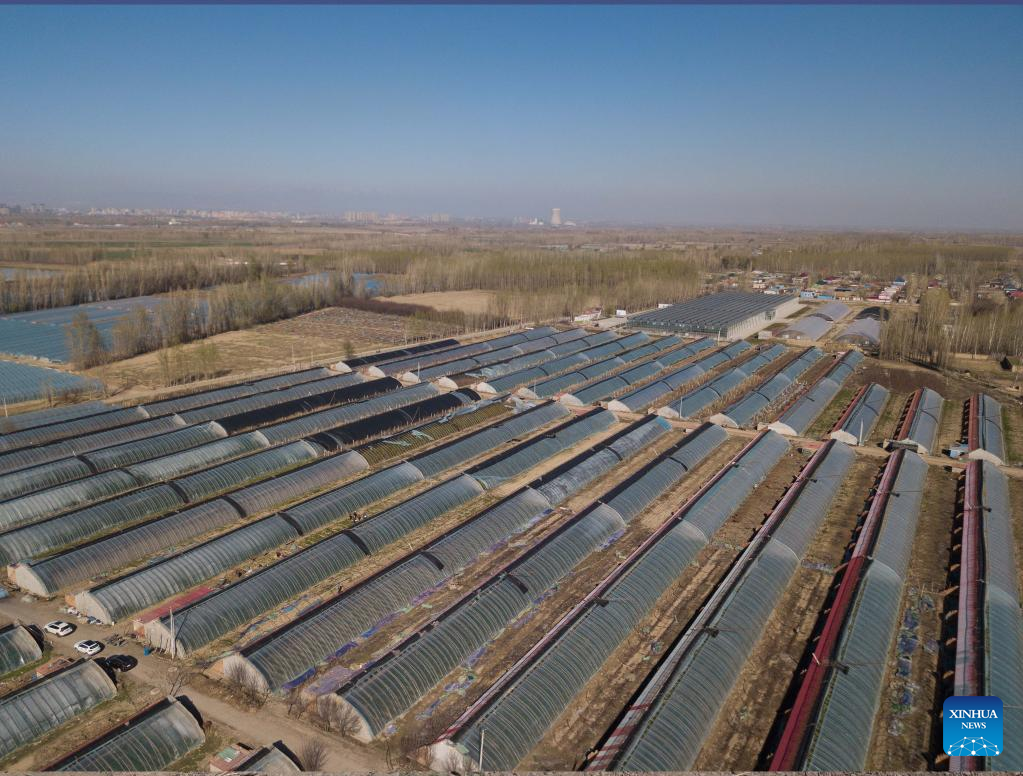
This aerial photo taken on April 1, 2023 shows vegetable greenhouses in Qapqal Xibe Autonomous County, northwest China's Xinjiang Uygur Autonomous Region.(Xinhua/Zhang Xiaocheng)
URUMQI, April 11 (Xinhua) -- Towed by a driverless tractor, a hill-drop planter moves forward and spreads out corn seeds at a fixed spacing. Meanwhile, a seed roller covers the seeds with soil and flattens the drip irrigation belt.
As it gets warmer, Luo Junjie, a 31-year-old farmer in Qapqal Xibe Autonomous County of Ili Kazak Autonomous Prefecture, a major grain-producing area in northwest China's Xinjiang Uygur Autonomous Region, is leading his team of 15 busy farmers.
The team mainly plants corn and wheat and has 13 sets of agricultural machinery, with functions ranging from plowing to sowing. On its contracted land covering about 533 hectares, full mechanization in planting corn and wheat is nearly achieved.
Equipped with the BeiDou Navigation Satellite System, the team's tractors and drones can operate automatically according to pre-planned routes.
"Our team's per hectare yield of corn reached some 19 tonnes last year. The figure has almost doubled compared to 2018 when I started contracting land," Luo said.
Luo is a college graduate majoring in interior design. Although his family suggested he seek opportunities in cities, he still decided to return to his hometown.
"I figured there was spare land in my hometown. So why not make good use of it?" Luo said, adding that he was inspired in 2017 by the national rural revitalization strategy, and also learned about the importance of modern agricultural machines.
He studied policies concerning the government's agricultural machinery purchase subsidies and introduced modern agricultural equipment. Through land circulation and seed breeding, his business scale significantly expanded. Last year, the team's per capita income reached 333,000 yuan (about 48,344 U.S. dollars).
Encouraged by the achievements of Luo's team, more and more farmers realized the importance of establishing modern agriculture production and management systems, said Yang Minshan, deputy head of the agriculture and rural affairs bureau in Qapqal Xibe Autonomous County.
"Farmers set up cooperatives to share costs and agricultural equipment, and apply drip irrigation technology on high-standard farmland. These methods bring convenience, reduce costs, and increase output," Yang added.
According to the regional department of agriculture and rural affairs, some 47.4 percent of Xinjiang's arable land has been developed into high-standard farmland, and the region has vowed to gradually transform all of its permanent basic farmland into high-standard farmland.
At the Xinliang Vegetable Professional Cooperative in Qapqal Xibe Autonomous County, seeds, pesticides, and fertilizers are densely piled up. Ma Chenglai, head of the cooperative, said that about 70 percent of agricultural materials are supplied by the All China Federation of Supply and Marketing Cooperatives, and these materials are then sold to the cooperative's 54 members at purchasing cost.
Besides providing members with agricultural materials and technology, Xinliang also helps them sell their over 130 hectares of vegetables grown in greenhouses.
Furthermore, local products are also sold across the country through the e-commerce platform Taobao and other online channels with the help of Xinliang.
"Our cooperative collectively sorts, stores, transports, and sells vegetables. As the products become more standardized, we have gained market share not only in our county but also in southern Xinjiang and Guangdong Province," Ma said. ■

Ma Chenglai, head of the Xinliang Vegetable Professional Cooperative, checks the vegetable growth at a greenhouse in Qapqal Xibe Autonomous County, northwest China's Xinjiang Uygur Autonomous Region, April 1, 2023. (Xinhua/Zhang Xiaocheng)

This aerial photo taken on April 3, 2023 shows the team of Luo Junjie working in a field in Qapqal Xibe Autonomous County, northwest China's Xinjiang Uygur Autonomous Region. (Xinhua/Zhang Xiaocheng)



